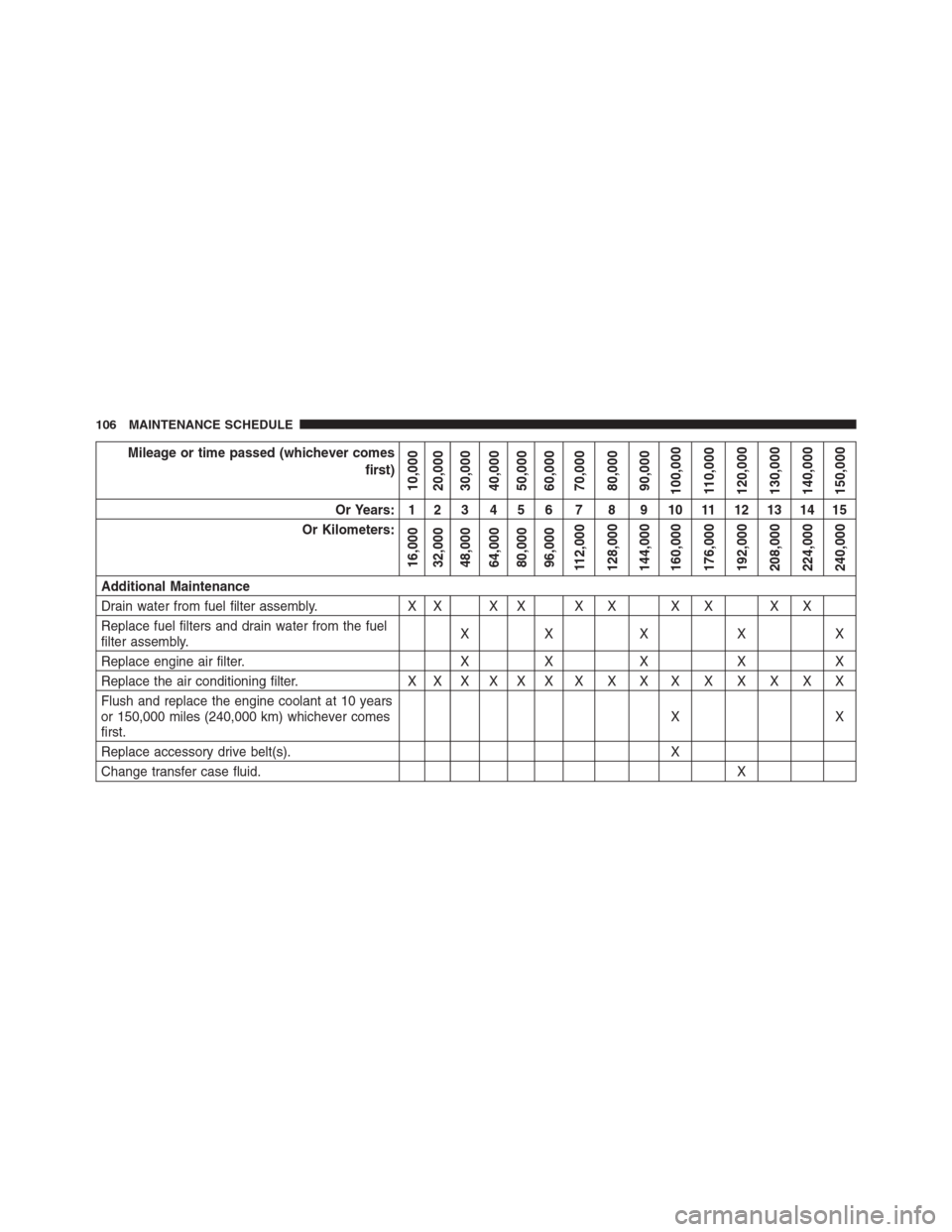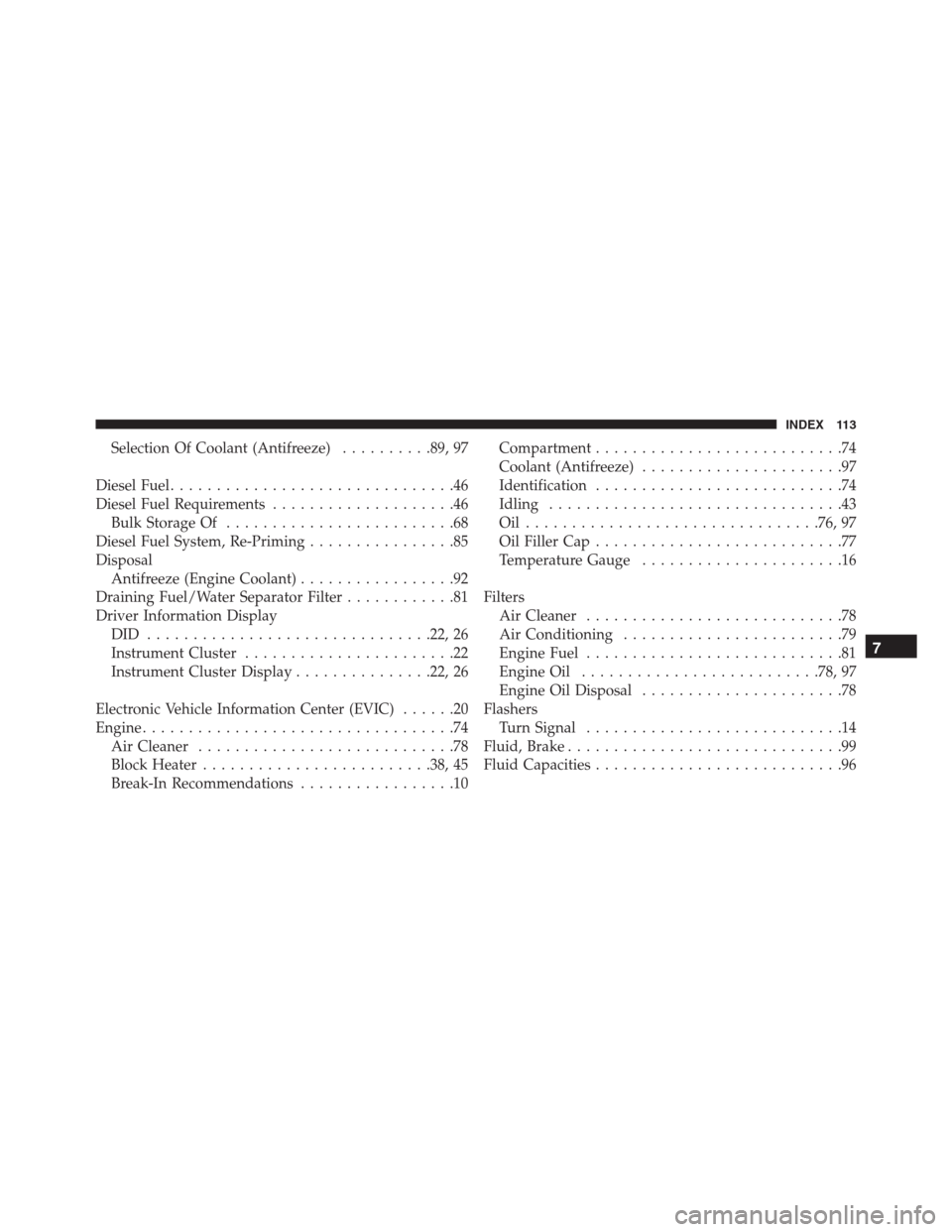2015 JEEP GRAND CHEROKEE air conditioning
[x] Cancel search: air conditioningPage 46 of 120

NOTE:Under certain conditions the engine fan will run
after the engine is turned off. These conditions are under
high load and high temperature conditions.
Cooling System Tips — Automatic Transmission
To reduce the potential for engine and transmission
overheating in high ambient temperature conditions,
take the following actions:
•City Driving — When stopped, shift the transmission
into NEUTRAL and increase engine idle speed.
•Highway Driving — Reduce your speed.
•Up Steep Hills — Select a lower transmission gear.
•Air Conditioning — Turn it off temporarily.
NOTE:If the coolant temperature is too high the A/C
will automatically turn off.
Do Not Operate The Engine With Low Oil
Pressure
If the low oil pressure warning light turns on while
driving, stop the vehicle and shut down the engine as
soon as possible. A chime will sound when the light turns
on.
NOTE:Do not operate the vehicle until the cause is
corrected. This light does not show how much oil is in the
engine. The engine oil level must be checked under the
hood.
CAUTION!
If oil pressure falls to less than normal readings, shut
the engine off immediately. Failure to do so could
result in immediate and severe engine damage.
44 STARTING AND OPERATING
Page 65 of 120

Paddle Shift Mode
•When using the Paddle Shift switches, select the
highest gear that allows for adequate performance and
avoids frequent downshifts. For example, choose “5” if
the desired speed can be maintained. Choose “4” or
“3” if needed to maintain the desired speed.
•To prevent excess heat generation, avoid continuous
driving at high RPM. Reduce vehicle speed as neces-
sary to avoid extended driving at high RPM. Return to
a higher gear or vehicle speed when grade and road
conditions allow.
Electronic Speed Control — If Equipped
•Do not use in hilly terrain or with heavy loads.
•When using the speed control, if you experience speed
drops greater than 10 mph (16 km/h), disengage until
you can get back to cruising speed.•Use speed control in flat terrain and with light loads to
maximize fuel efficiency.
Cooling System
To reduce potential for engine and transmission over-
heating, take the following actions:
City Driving
When stopped for short periods of time, shift the trans-
mission into NEUTRAL and increase engine idle speed.
Highway Driving
Reduce speed.
Air Conditioning
Turn off temporarily.
4
STARTING AND OPERATING 63
Page 77 of 120

MAINTENANCE PROCEDURES
The pages that follow contain therequiredmaintenance
services determined by the engineers who designed your
vehicle.
Besides those maintenance items specified in the fixed
maintenance schedule, there are other components which
may require servicing or replacement in the future.
CAUTION!
•Failure to properly maintain your vehicle or per-
form repairs and service when necessary could
result in more costly repairs, damage to other
components or negatively impact vehicle perfor-
mance. Immediately have potential malfunctions
examined by an authorized dealership or qualified
repair center.
(Continued)
CAUTION!(Continued)
•Your vehicle has been built with improved fluids
that protect the performance and durability of your
vehicle and also allow extended maintenance inter-
vals. Do not use chemical flushes in these compo-
nents as the chemicals can damage your engine,
transmission, power steering or air conditioning.
Such damage is not covered by the New Vehicle
Limited Warranty. If a flush is needed because of
component malfunction, use only the specified
fluid for the flushing procedure.
5
MAINTAINING YOUR VEHICLE 75
Page 95 of 120

Points To Remember
NOTE:When the vehicle is stopped after a few miles/
kilometers of operation, you may observe vapor coming
from the front of the engine compartment. This is nor-
mally a result of moisture from rain, snow, or high
humidity accumulating on the radiator and being vapor-
ized when the thermostat opens, allowing hot engine
coolant (antifreeze) to enter the radiator.
If an examination of your engine compartment shows no
evidence of radiator or hose leaks, the vehicle may be
safely driven. The vapor will soon dissipate.
•Do not overfill the coolant expansion bottle.
•Check the coolant freeze point in the radiator and in
the coolant expansion bottle. If engine coolant (anti-
freeze) needs to be added, the contents of the coolant
expansion bottle must also be protected against freez-
ing.•If frequent engine coolant (antifreeze) additions are
required, the cooling system should be pressure tested
for leaks.
•Maintain engine coolant (antifreeze) concentration at a
minimum of 50% OAT coolant (conforming to
MS.90032) and distilled water for proper corrosion
protection of your engine which contains aluminum
components.
•Make sure that the coolant expansion bottle overflow
hoses are not kinked or obstructed.
•Keep the front of the radiator clean. If your vehicle is
equipped with air conditioning, keep the front of the
condenser clean.
•
Do not change the thermostat for Summer or Winter
operation. If replacement is ever necessary, install ONLY
the correct type thermostat. Other designs may result in
unsatisfactory engine coolant (antifreeze) performance,
poor gas mileage, and increased emissions.
5
MAINTAINING YOUR VEHICLE 93
Page 108 of 120

Mileage or time passed (whichever comes
first)
10,000
20,000
30,000
40,000
50,000
60,000
70,000
80,000
90,000
100,000
110,000
120,000
130,000
140,000
150,000
Or Years: 1 2 3 4 5 6 7 8 9 10 11 12 13 14 15
Or Kilometers:
16,000
32,000
48,000
64,000
80,000
96,000
112,000
128,000
144,000
160,000
176,000
192,000
208,000
224,000
240,000
Additional Maintenance
Drain water from fuel filter assembly. X X X X X X X X X X
Replace fuel filters and drain water from the fuel
filter assembly.XX X X X
Replace engine air filter. X X X X X
Replace the air conditioning filter. X X X X X X X X X X X X X X X
Flush and replace the engine coolant at 10 years
or 150,000 miles (240,000 km) whichever comes
first.XX
Replace accessory drive belt(s). X
Change transfer case fluid.X
106 MAINTENANCE SCHEDULE
Page 114 of 120

Adding Engine Coolant (Antifreeze).............90
Adding Fuel..............................65
Air Bag Light.............................21
Air Cleaner, Engine (Engine Air Cleaner Filter).....78
Air Conditioning Filter......................79
Alarm (Security Alarm)......................21
Antifreeze (Engine Coolant)...................89
Capacities.............................96
Disposal..............................92
Anti-Lock Warning Light.....................13
Automatic Transmission
Fluid Type.............................99
Axle Fluid...............................99
Battery.................................87
Brake Fluid..............................99
Brake System.............................94
Fluid Check............................94
Master Cylinder.........................94Warning Light..........................17
Capacities, Antifreeze (Engine Coolant)...........96
Capacities, Fluid...........................96
Caps, Filler
Oil (Engine)............................77
Radiator (Coolant Pressure).................92
Charge Air Cooler.........................94
Coolant Pressure Cap (Radiator Cap)............92
Cooling System...........................88
Adding Coolant (Antifreeze)................90
Coolant Capacity........................96
Coolant Level...........................88
Disposal Of Used Coolant..................92
Drain, Flush, And Refill...................89
Points To Remember......................93
Pressure Cap...........................92
Radiator Cap...........................92
112 INDEX
Page 115 of 120

Selection Of Coolant (Antifreeze)..........89, 97
Diesel Fuel...............................46
Diesel Fuel Requirements....................46
Bulk Storage Of.........................68
Diesel Fuel System, Re-Priming................85
Disposal
Antifreeze (Engine Coolant).................92
Draining Fuel/Water Separator Filter............81
Driver Information Display
DID ...............................22, 26
Instrument Cluster.......................22
Instrument Cluster Display...............22, 26
Electronic Vehicle Information Center (EVIC)......20
Engine..................................74
Air Cleaner............................78
Block Heater.........................38, 45
Break-In Recommendations.................10Compartment...........................74
Coolant (Antifreeze)......................97
Identification...........................74
Idling................................43
Oil................................76, 97
Oil Filler Cap...........................77
Temperature Gauge......................16
Filters
Air Cleaner............................78
Air Conditioning........................79
Engine Fuel............................81
Engine Oil..........................78, 97
Engine Oil Disposal......................78
Flashers
Turn Signal............................14
Fluid, Brake..............................99
Fluid Capacities...........................96
7
INDEX 113